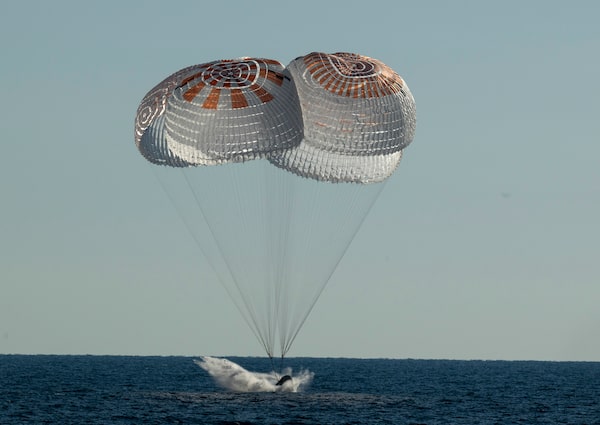
In this handout image provided by NASA, the SpaceX Crew Dragon Freedom spacecraft is seen as it lands with NASA astronauts Kjell Lindgren, Robert Hines, Jessica Watkins, and ESA (European Space Agency) astronaut Samantha Cristoforetti aboard, in the Atlantic Ocean on Oct. 14, 2022, off the coast of Jacksonville, Fla.(NASA/Bill Ingalls)/Getty Images
The fourth long-duration astronaut team launched by SpaceX to the International Space Station (ISS) safely returned to Earth on Friday, splashing down in the Atlantic Ocean off Florida after nearly six months of research aboard the orbital outpost.
The SpaceX Crew Dragon capsule dubbed Freedom, carrying three U.S. NASA astronauts and an Italian crewmate from the European Space Agency, parachuted into the sea at the conclusion of a five-hour autonomous flight home from the ISS.
Splashdown under clear skies, at about 4:55 p.m. EDT (2055 GMT), was carried live by a joint NASA-SpaceX webcast.
A member of the Freedom crew, believed to be NASA astronaut Kjell Lindgren, 49, radioed moments later that the capsule was upright and stable in the water.
“SpaceX, from Freedom, thank you for an incredible ride up to orbit and an incredible ride home. Glad to be back,” he added.
Rounding out the Freedom crew, which began its stay in orbit on April 27, were fellow Americans Jessica Watkins, 34, and Bob Hines, 47, as well as Italy’s Samantha Cristoferetti, 45, who was commander of their ISS expedition. Watkins became the first African-American woman to join a long-duration ISS mission.
Camera shots from inside the crew compartment showed the astronauts strapped in their seats, garbed in helmeted white-and-black spacesuits.
Splashdown-recovery teams were expected to take at least an hour to reach the heat-scorched capsule bobbing in the water, hoist it onto the deck of a retrieval vessel and let the astronauts out for their first breath of fresh air in more than 24 weeks.
Windy, rainy sea conditions earlier in the week delayed the flight back to Earth by a couple days.
The return from orbit followed a fiery re-entry plunge through Earth’s atmosphere generating frictional heat that sent temperatures outside the capsule soaring to 3,500 degrees Fahrenheit (1,930 degrees Celsius).
Two sets of parachutes billowed open above the capsule in the final stage of descent, slowing its fall to about 15 miles per hour (24 kph) before the craft hit the water off the coast of Jacksonville, Florida.
Applause and cheers from the SpaceX flight control center in suburban Los Angeles was heard over the webcast.
During their 170 days aboard the space station, the crew orbited Earth 2,720 times - about once every 90 minutes - to log some 72 million miles (116 million km) in space, according to NASA.
The returning team was designated as “Crew-4,” the fourth full-fledged long-duration group of astronauts launched to ISS by SpaceX since the private rocket company founded by Tesla Inc CEO Elton Musk began flying NASA personnel in May 2020.
The crew contributed to hundreds of science experiments and technology demonstrations while in orbit.
Highlights included research on microgravity-induced changes in human cells resembling those associated with aging on Earth, and documenting the effects of dietary improvements during spaceflight on immune function, gastrointestinal health and nutrition indicators.
They also participated in studies of fire and fuel behavior in weightlessness, and the growth of plants in liquid- and air-based growth materials in place of soil.
Their exit came a week after their replacement team, Crew-5, arrived aboard the station - a Russian cosmonaut, a Japanese astronaut and two NASA crew mates, including the first Native American woman sent to orbit.
Crew-5 is remaining on ISS for now with two other Russians and a third American who shared a Soyuz flight to the ISS in September. One of those cosmonauts, Serge Prokofiev, assumed ISS command from Cristoferetti before Crew-4’s departure.
ISS, spanning the length of a U.S. football field, has been continuously occupied since 2000, operated by a U.S.-Russian-led partnership that includes Canada, Japan and 11 European countries. (\\
This content appears as provided to The Globe by the originating wire service. It has not been edited by Globe staff.